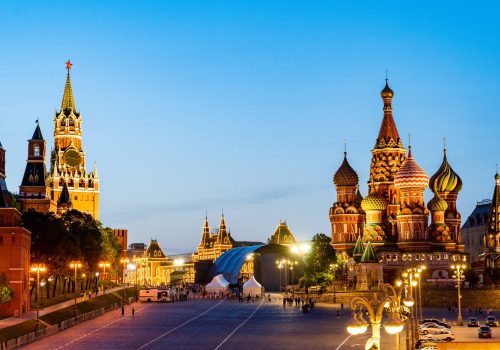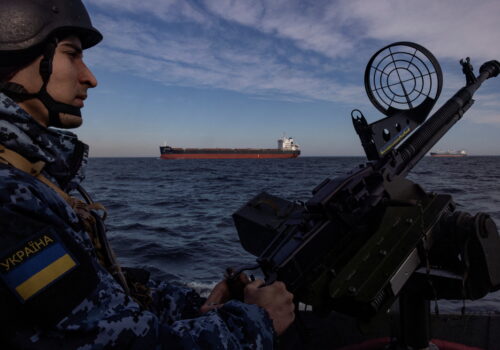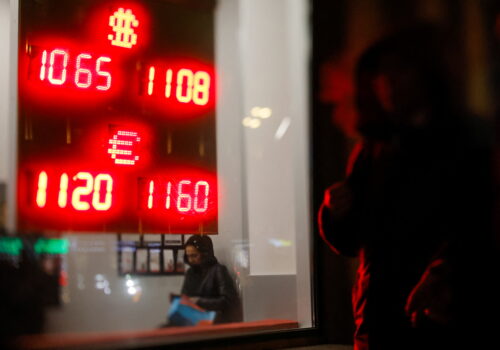There’s a right way to lift sanctions on Russia. Follow these Dos and Don’ts.
The United States has a long history of leveraging economic power and restrictive economic measures to advance its national security objectives. It also has a history of offering sanctions relief as a bargaining tool in negotiations to achieve its desired end states. Sanctions and the economic pain they inflict can effectively bring an adversary to the negotiating table, and sanctions relief can often get the adversary to agree to a deal.
After three years of increasingly restrictive sanctions targeting Russia over its unlawful invasion of Ukraine, Russia is feeling the pain. Its economic growth is minimal, and it has retracted into a “wartime economy” that is driven by military spending and government support. Annual inflation remains high, holding at 10 percent as of February. For comparison, a healthy inflation rate is generally between 2 percent and 3 percent per year. The Central Bank of the Russian Federation held interest rates at an all-time-high 21 percent in February. Russia is having trouble selling its oil as a result of sanctions and the expiration of General License 8L earlier this month, which makes it even more difficult to buy Russian oil without risking exposure to secondary sanctions.
The sanctions are working, and Russia’s economy is in a downturn. Moreover, despite Russian success in driving Ukrainian forces out of most of Russia’s Kursk region, Ukraine is holding off Russian advances and inflicting serious casualties. In short, the United States, its Group of Seven (G7) partners, and Ukraine have the upper hand in negotiations to end the war. They should use it.
As the Trump administration pursues a deal with Russian President Vladimir Putin, US President Donald Trump must determine which US sanctions should be eased or lifted and when that sanctions relief should come as part of a negotiated peace settlement. To ensure Trump can negotiate peace from a position of strength and to hold Putin accountable to his end of the deal, we offer the following do’s and don’ts of lifting US sanctions on Russia.
Don’t give something for nothing
Do not lift or offer to lift sanctions to generate “goodwill.” Russia will pocket concessions and consider them a sign of weakness, emboldening Moscow to make further demands. Don’t lift any sanctions in advance of full and verified Russian adherence to the terms of a cease-fire. Russian attacks on Kyiv with Iranian-made drones this past weekend and ahead of cease-fire talks in Riyadh further demonstrate why sanctions should stay in place.
Do suggest that lifting sanctions would be part of a settlement
Teasing and offering in general can be useful. But see above.
Do intensify sanctions
The United States should ramp up some sanctions, especially against the Russian oil tanker “ghost fleet,” if Russia continues to slow-walk negotiations—for example, by resisting a cease-fire or adding unacceptable conditions to it.
Don’t lift all sanctions until Russia is out of Ukraine altogether
Some sanctions, including those related to sensitive technology and energy, should remain in place as long as Russia is illegally occupying Ukrainian territory.
Do ease sanctions on individuals
Lifting individual sanctions can be a high-profile but substantively less impactful early move. Continued vigilance on Russian oligarchs, disguised Russian investment, and hidden assets is important. A corollary to this: do not weaken financial transparency and anti-money laundering rules or let oligarchs use US cutouts for their holdings.
Do develop a plan for gradually easing financial restrictions and Russia’s reentry into SWIFT and the global financial system
Include measurable and verifiable benchmarks connected to cease-fire terms. At a minimum, this includes returning Ukrainian children to their Ukrainian families, releasing prisoners of war, halting overt or covert attacks against Ukraine and its allies, and establishing benchmarks to disconnect Russian payment systems and channels from sanctioned regimes such as Iran, North Korea, Venezuela, Cuba, and China.
As we have discussed in our analysis of the Axis of Evasion, Russia is working with China, Iran, North Korea, and other US adversaries to generate revenue, move funds across borders, and develop alternative payment systems. If Russia is to fully reengage in the US-led global financial system, then it must financially detach itself from these alternative payment systems and regimes sanctioned by the United States. Easing restrictions on access to Western financial systems, investment, and lending is a high-impact concession that should be left until late in the process, only after Russia has demonstrated its commitments to the outlined terms.
Reconnecting Russia with the Society for Worldwide Interbank Financial Telecommunication, known as SWIFT, will require the removal of European Union (EU) sanctions on Russian banks. SWIFT is headquartered in Brussels, within EU jurisdiction, and it must comply with EU laws and sanctions. For the United States to gradually ease financial restrictions, and for Russia to reenter SWIFT and reestablish corresponding banking relationships, the EU will need to be involved in coordination and synchronization.
Do go slow on lifting energy sanctions, and don’t lift all of them
Trump has long appreciated the danger of reliance on Russian energy and Nord Stream 2. The Europeans and even the Germans finally agree. The United States and its allies should retain restrictions on Russian energy exports sufficient to:
- keep the pressure on Russia to adhere to all elements of a Ukraine deal;
- after that, maintain Europe’s hard-won energy independence from Russia, and
- allow the United States to replace Russia, especially as a supplier of liquefied natural gas (LNG).
The United States should retain European markets, and Russia should chase lower-value Asian markets with more expensive transportation legs. The United States should maintain sanctions on the Russian oil and LNG sectors, including oil field services and refining technology, until late in the process. US negotiators determining when to lift energy-related sanctions on Russia should consider Trump’s strategy to advance US energy dominance. Russia is an energy competitor to the United States. The White House lifting restrictions on Russian oil too early or by too much could work against US plans for advancing energy dominance.
Do make the easing of sanctions reversible
The Trump administration should put in place “snap-back” provisions and avoid dependence on Russian supplies or inputs, including enriched uranium. Snap-back provisions can be used to hold Russia accountable should it break a cease-fire agreement or peace deal.
Don’t lift high-tech export controls
Do not ease Russia’s ability to upgrade military equipment, energy, artificial intelligence (AI), or any other technology. Maintain technology advantages. As a result of sanctions, Russia relies heavily on China and India to procure the sensitive technology that it needs on the battlefield and to support its economy. The United States, through sanctions, export controls, diplomacy, and enforcement actions has put pressure on China and India for their support of Russia. Easing restrictions on technology will embolden China and runs the risk of creating additional export controls enforcement challenges should Russia provide sensitive Western technology to Beijing. Determinations on lifting technology sanctions on Russia must consider the United States’ technology and innovation equities as well as US dominance in AI.
Do engage with the US private sector
A divergence in sanctions toward Russia between the United States and the G7 sanctioning coalition partners will create significant compliance challenges for many US-owned and controlled multinational corporations, financial institutions, and investors. The private sector is the pointy end of the spear in economic statecraft, and the administration should seek its input. The United States changing its sanctions policies toward Russia will have significant impacts on the financial, energy, and technology sectors.
Further, the administration should engage with the private sector to better understand the challenges businesses faced when they vacated Russia or wound down their operations there. Many companies faced heavy fines, lawsuits, harassment of their employees, and other forms of retribution. The private sector’s concerns and equities should be accounted for when considering lifting sanctions.
Do hold the immobilized Russian assets as surety for Ukraine’s reconstruction
After Russia’s full-scale invasion of Ukraine in 2022, G7 partners immobilized nearly $300 billion worth of Russian sovereign assets held across multiple jurisdictions. These assets should not be returned to Russia. The best option would be for Washington and its allies to confiscate the assets for Ukraine’s reconstruction and further military support for Ukraine. At a minimum, G7 countries should retain control over the assets as surety for a Russian contribution to Ukrainian reconstruction and adherence to the terms of a cease-fire. The majority of the immobilized funds are held in Europe and therefore the United States must continue to coordinate with Europe on this issue. The interest generated by the immobilized assets is currently providing the income stream repaying the fifty-billion-dollar loan that the United States and Western allies provided to Ukraine in late 2024. The United States and its Western allies would be exposed to liability for the fifty billion dollars should the immobilized funds be released and the principal given to Russia.
The economic pressure and restrictive measures the United States and its partners placed on Russia have given them the upper hand. If Russia is ready to negotiate and make a deal that secures Ukraine’s future and safety, they should strategically play their hand and consider the dos and don’ts of lifting sanctions. The stakes are too high to fall for Putin’s bluff and fold.
Daniel Fried is the Weiser Family distinguished fellow at the Atlantic Council. He is also on the board of directors of the National Endowment for Democracy and a visiting professor at Warsaw University. Fried served for forty years in the US Foreign Service. He is a former US ambassador to Poland, assistant secretary of state for Europe, and coordinator of sanctions policy. Follow him on X @AmbDanFried.
Kimberly Donovan is the director of the Economic Statecraft Initiative within the Atlantic Council’s GeoEconomics Center. She is a former senior Treasury official and National Security Council director. Follow her at @KDonovan_AC.
Further reading
Thu, Sep 8, 2022
Russia Sanctions Database
Econographics By
The Atlantic Council’s Russia Sanctions Database tracks the level of coordination among Western allies in sanctioning Russian entities, individuals, vessels, and aircraft, and shows where gaps still remain.
Tue, Mar 25, 2025
Experts react: What to know about the US-led Black Sea cease-fire deal with Russia and Ukraine
New Atlanticist By
Atlantic Council experts plumb the depths of the new US agreements with Moscow and Kyiv to end hostilities on the Black Sea.
Wed, Feb 26, 2025
Why the US should not lift sanctions against Russia
New Atlanticist By Charles Lichfield
Sanctions are having an unmistakable effect, albeit below the inflated expectations of many in the West in early 2022. Lifting them now would be a mistake.
Image: A view shows the Moscow City international business centre behind the Borovitskaya tower of the Kremlin during sunset in Moscow, Russia, February 23, 2025. REUTERS/Maxim Shemetov


